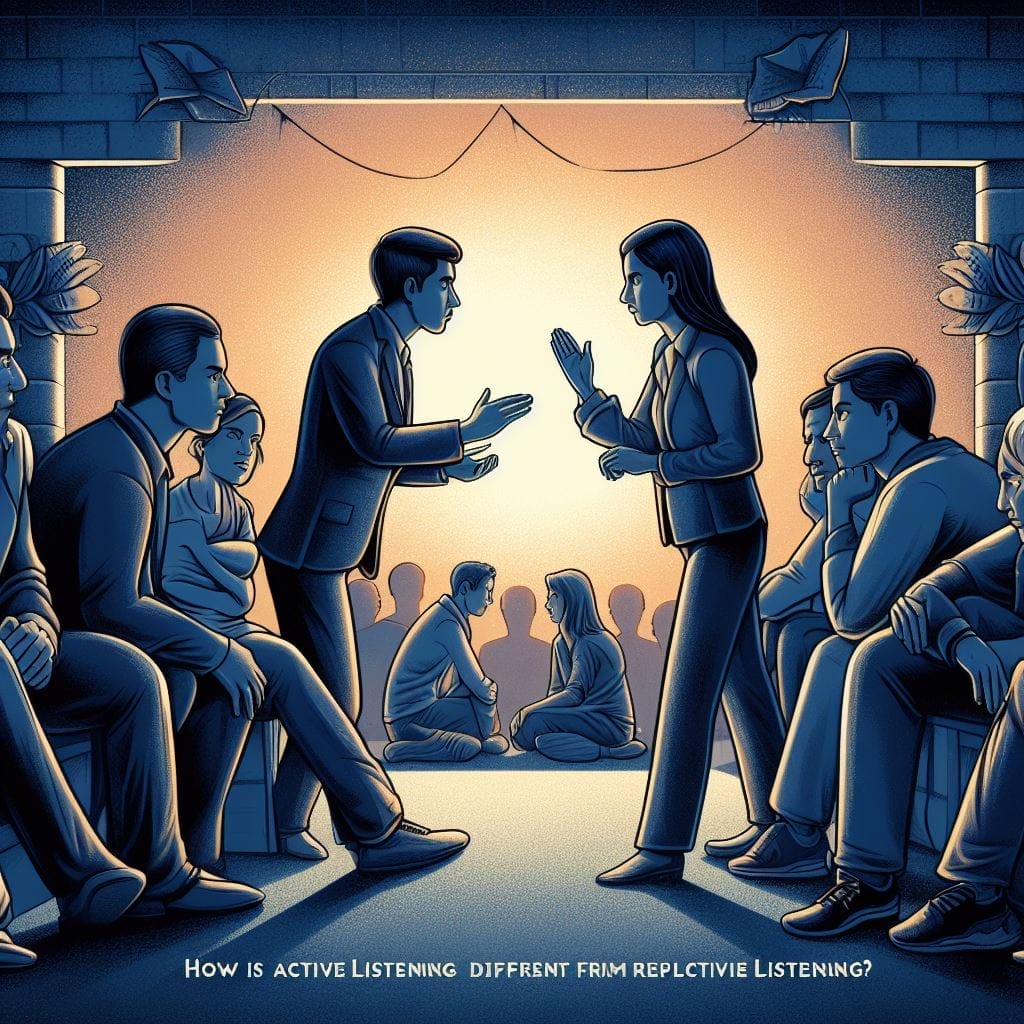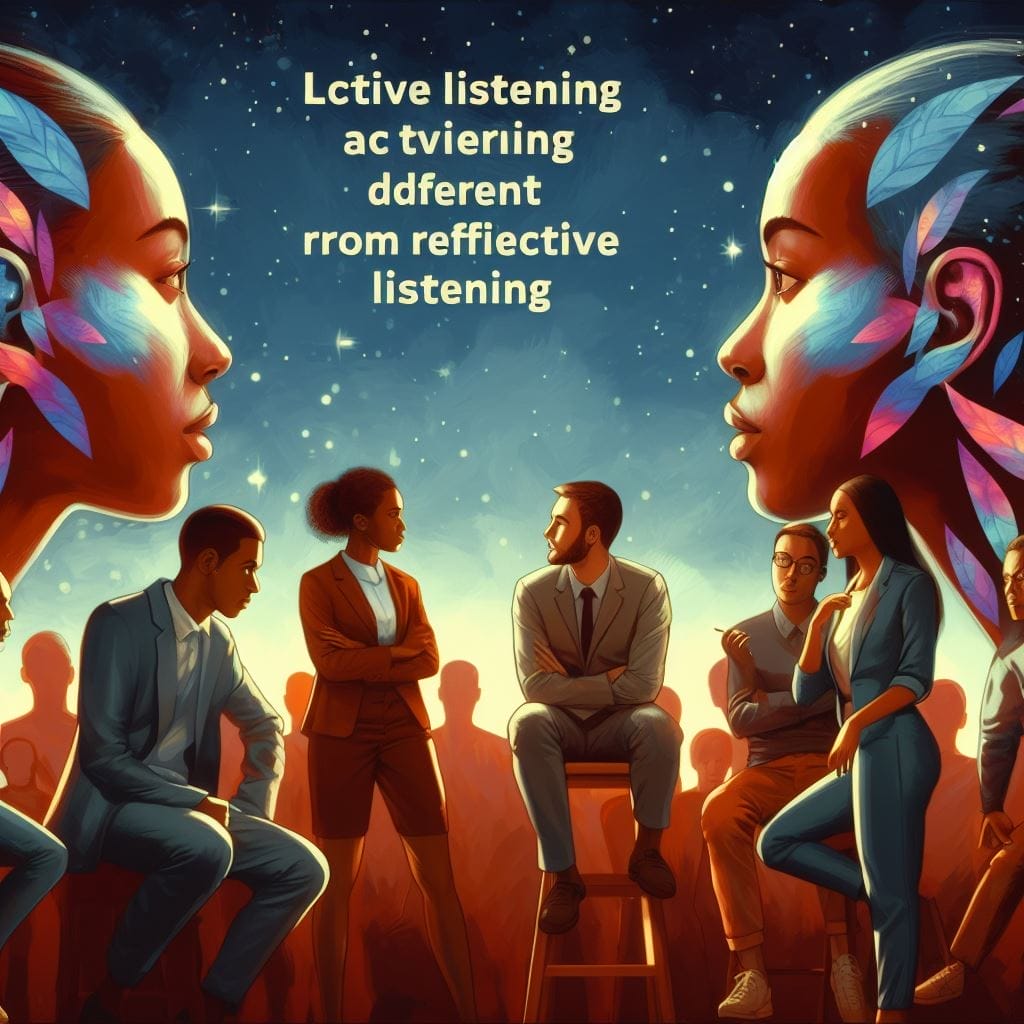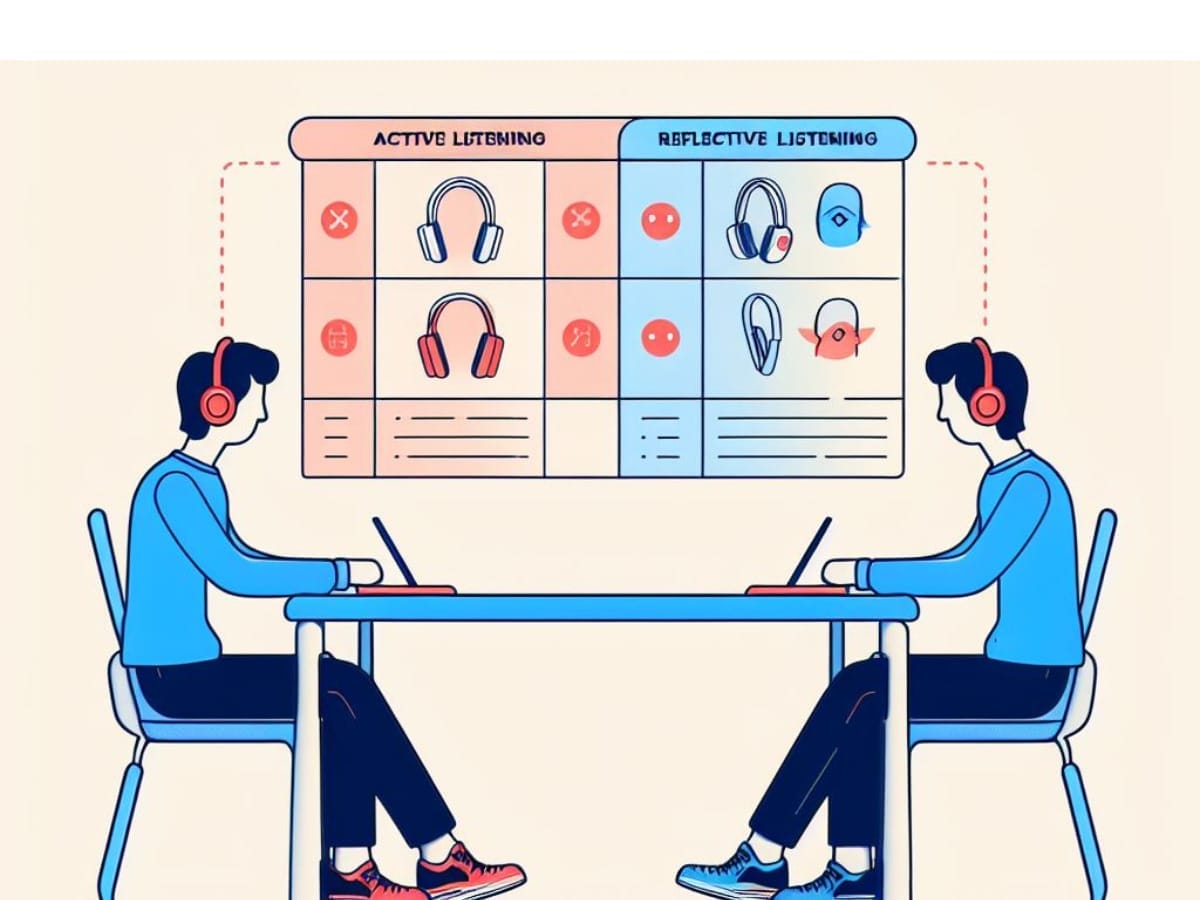Introduction
In the intricate dance of human communication, the skills of active and reflective listening are akin to the guiding stars that light our way. These listening techniques go beyond simple hearing; they are essential to developing into genuine listeners and proficient communicators. Today in this guide, you will get the answer to the question, “How is Active Listening Different from Reflective Listening?” in this tutorial.
Consider the following scenario: a friend or coworker is sharing their thoughts, their world, with you. As you engage in active listening, your body language speaks volumes. Your eye contact assures them that you’re fully present, while a gentle nod provides a reassuring cue that their words are valued. You don’t interrupt, allowing the speaker to express themselves freely. Instead, you paraphrase, providing feedback that demonstrates your commitment to improve communication.
But there’s another facet to this art. It’s the power of reflective listening. Here, the focus shifts from responding actively to making the speaker feel heard and understood. In this mode, you paraphrase not to provide feedback, but to mirror the emotions and thoughts of the speaker. Your nonverbal cues and verbal acknowledgments encourage them to delve deeper into their feelings. It’s as if you hold up a mirror that reflects their world, free from judgment or interruptions. The speaker is free to feel heard, and you simply listen.
Effective listening requires a balanced approach, where active and reflective listening work in harmony. It’s approximately providing a secure space for the speaker to specify themselves, be it in hassle-fixing, discussions, or emotionally charged conditions. The goal is simple but profound: to make the speaker’s experience heard and understood.
As we embark on this adventure, we’ll discover the intricacies of both energetic and reflective listening. We’ll delve into the techniques that can help you interact and replicate, provide support, and inspire the speaker to open up. It’s a voyage that can transform your listening skills and your relationships, one where the destination is not just hearing words but truly listening to the speaker.
Come explore the art of listening with us, where the emphasis is on hearing and understanding as much as what is spoken. Let’s discover the magic of making others feel heard and understood.
Key Takeaways
- The Dual Power of Listening: By exploring the nation-states of energetic and reflective listening, you’ll hold close that listening is a multifaceted artwork. It’s no longer just about listening to but about enticing and reflecting, about making others’ experiences heard and understood.
- Engage and Reflect: As an active listener, you’ll examine the significance of preserving eye contact, the use of nonverbal cues, and nodding to make the speaker experience valued. You’ll grasp the artwork of paraphrasing to enhance conversation and offer an environment wherein people can explicit themselves freely.
- Mirror Emotions with Reflective Listening: On the turn side, reflective listening is set mirroring emotions, not simply words. You’ll find a way to make the speaker feel heard and understood by using displaying empathy and reflecting on their thoughts and feelings without judgment.
- Balancing Act: Effective listening requires the capacity to replace between energetic and reflective listening, adapting to different situations. You’ll advantage insights into while to engage and while to mirror, depending on the needs of the instant.
- Transforming Relationships: Your relationships may go from just excellent to extraordinary with the tools you acquire on this trip. Your capacity to listen and understand people will increase credibility and trust like never before.
- Enhanced Communication: These skills go beyond personal relationships. You’ll discover that better communication enables you to make more informed decisions resolve conflicts and solve problems in both your personal and professional lives.
- Empowerment: You empower everyone around you and yourself when you develop into a skilled listener. Being genuinely understood and understood in return is a blessing that never ends.
To sum up, this blog serves as your manual for learning the skill of attentive and engaged listening. It’s a journey that promises deeper connections, improved relationships, and a greater understanding of the people in your life. So, take these key takeaways with you, and let the magic of listening unfold in your world.

The Power of Listening
Listening is greater than just hearing phrases; it’s approximately truly comprehending what’s being said and know-how the nuances that words by myself can’t deliver. Imagine a conversation as a winding route, and listening is the compass that ensures you live on course.
Consequences of Poor Listening
However, when listening falters, the consequences can be profound. Misunderstandings and conflicts can erupt like sudden storms, shrouding the path in confusion. Consider this:
“Sarah’s misheard instructions led to a culinary catastrophe. Instead of adding a pinch of salt, she added a cup. Her dinner guests were in for a salty surprise.”
This anecdote vividly illustrates how now not listening actively or reflectively can result in surprising outcomes. Now, allow’s explore the art of energetic listening.
The Art of Engagement Through Active Listening
Active listening is a rhythmic verbal and empathetic interplay between people, much like a dance. It’s now not just listening to; it’s soaking up, interpreting, and responding in a manner that indicates real interest.
Characteristics of Active Listening
Active listeners engage in various ways:
- Maintaining eye contact: This simple act conveys undivided interest, making the speaker sense valued.
- Nodding and using verbal cues: Phrases like “I see,” or “Go on” allow the speaker to understand you’re now not simply listening to, but additionally listening.
- Providing feedback without interrupting: It entails actively processing what the speaker is announcing and imparting insights or questions once they’ve finished.
Let’s take a look at an actual-existence scenario in which energetic listening may be a conflict resolver:
Imagine an administrative center war of words. Two colleagues, Tom and Emily, have one-of-a-kind ideas approximately how to approach a venture. Emily actively listens to Tom’s angle, nodding and asking clarifying questions. This no longer simply defuses tension however additionally enables them to discover common ground, leading to a greater effective answer.
Techniques for Active Listening
Active listening is an essential verbal exchange talent that includes giving your complete attention to the speaker. By actively listening, you may make the speaker’s experience heard and valued, which enables you to construct stronger relationships. Here are some strategies to beautify your active listening competencies:
| Technique | Description |
|---|---|
| Listen to the speaker | Focus your attention on the speaker, putting aside any distractions. Avoid interrupting or thinking about how you will respond. |
| Use body language | Nonverbal cues such as eye contact, nodding, and facing the speaker can show that you are paying attention and engaged in the conversation. |
| Show that you understand | Paraphrasing and summarizing what the speaker has said can help ensure that you have correctly understood their message. |
| Ask questions | Asking open-ended questions can help you gain more insight into the speaker’s thoughts and feelings and encourage them to elaborate on their message. |
Drawing Close: A Tense and Reflective Audience
Active listening and reflective listening are two essential competencies in the realm of powerful communication. Observing the speaker, listening to their tone, and revealing your hobby with statements like “I apprehend what you’re saying” are all a part of active listening.
On the opposite hand, Reflective Listening goes deeper. It entails responding with empathy and information, not only to what the speaker is pronouncing but also to their mind and feelings. It means validating their feelings through repeating or paraphrasing their message back to them. This not only builds stronger connections but also helps in conflict resolution.
Reflective Listening Unveiled
Reflective Listening is the mirror that reflects emotions and thoughts. It is going past the surface, diving deep into the speaker’s emotions and thoughts, creating a profound connection. It’s a skill that lets the listener not just hear but apprehend, empathize, and validate the speaker’s experience.
Key Aspects of Reflective Listening
To without a doubt draw close to the essence of Reflective Listening, one should discover its key aspects:
- Paraphrasing the Speaker’s Words: In the region of Reflective Listening, paraphrasing is your compass. It includes rephrasing the speaker’s phrases, demonstrating that you’ve heard and understood them. This simple act conveys appreciation for their attitude and opens the door to similarly communicate.
- Acknowledging and Validating Feelings: Reflective Listening isn’t just about words; it’s approximately emotions too. The reflective listener doesn’t pull away from acknowledging and validating the speaker’s feelings. This validation is a powerful device for constructing belief and rapport.
- Asking Open-Ended Questions to Delve Deeper: To find the hidden gemstones of the speaker’s mind and emotions, the reflective listener employs open-ended questions. These questions are like keys that release doors, allowing the speaker to percentage extra.
Methods for Introspective Hearing
Reflective listening is a powerful conversation ability that includes mirroring and validating the speaker’s thoughts and feelings. It shows empathy and understanding. Here are some techniques to enhance your reflective listening skills:
| Technique | Description |
|---|---|
| Repeat the speaker’s words | Repeating the speaker’s exact words to acknowledge and confirm their message. |
| Parrot the speaker’s emotions | Mirroring the emotions the speaker expresses, such as joy, sadness, or frustration. |
| Validate the speaker’s feelings | Confirming the legitimacy of the speaker’s emotions and assuring them that their feelings are valid. |
| Encourage elaboration | Using prompts like “Tell me more” or “Can you explain further?” to invite the speaker to share additional details. |
| Offer empathetic responses | Expressing empathy and understanding through phrases like “I can imagine that must be tough” or “I’m here for you.” |
A Scenario of Transformation: Reflective Listening in Action
Imagine a scenario where colleagues, Sarah and Alex, discover themselves embroiled in an annoying dialogue about a project closing date. Sarah is frustrated because she believes the closing date is unrealistic, while Alex, the project supervisor, is adamant about sticking to the schedule.
In this charged ecosystem, Sarah employs the artwork of Reflective Listening. She paraphrases Alex’s concerns, saying, “I recognize that you’re worried about meeting the closing date, and you need to ensure the task’s success.”
This simple act of paraphrasing shifts the tone of the communication. Alex feels heard and understood, which opens the door for a similar discussion. Reflective Listening, in this example, diffuses tension, as each events begin to join on a greater profound level.

Active vs. Reflective Listening: A Side-with the Aid of-Side Comparison
Active and reflective listening are crucial conversation skills that contribute to powerful interpersonal relationships. Here’s a facet-by means of-side assessment of these techniques:
| Aspect | Active Listening | Reflective Listening |
|---|---|---|
| Definition | Focuses on fully engaging with the speaker by giving full attention and using verbal and non-verbal cues. | involves reflecting and confirming the thoughts and feelings of the speaker to demonstrate understanding and empathy. |
| Core Objective | Understanding the speaker’s message and encouraging open dialogue. | Acknowledging the speaker’s emotions and supplying an emotional manual |
| Key Techniques | – Listen attentively without interruptions. – Use non-verbal cues (e.g., eye contact, nodding) to show engagement. – Ask open-ended questions to prompt further discussion. – Summarize or paraphrase the speaker’s words. | – Repeat the speaker’s words to confirm understanding. – Parrot the speaker’s emotions to mirror their feelings. – Validate the speaker’s feelings to show empathy. – Encourage the speaker to share more by asking for elaboration. – Offer empathetic responses to provide emotional support. |
| Benefits | – Encourages open and honest communication. – Helps clarify the speaker’s message. – Builds rapport and trust. – Demonstrates active engagement. | – Demonstrates empathy and understanding. – Validates the speaker’s emotions. – Provides emotional support. – Encourages the speaker to express themselves. |
| Use Cases | Useful in various conversations, including problem-solving, interviews, and group discussions. | Particularly precious in situations that require emotional assistance, consisting of consoling a friend or providing counseling. |
| Example Scenario | In a team meeting, actively listening to a colleague’s proposal and asking questions to gain a deeper understanding. | Consoling a pal who’s going through a tough time via reflecting on their emotions and presenting assistance. |
Both lively and reflective listening play crucial roles in powerful communication, however, they serve one-of-a-kind functions and are applicable in numerous contexts. Understanding a way to use each approach can appreciably beautify your interpersonal communication abilities.
The Power of Reflective Listening
Reflective Listening is a verbal exchange approach that possesses transformative energy. It allows the listener to understand the speaker’s mind, emotions, and angle. This talent includes more than simply hearing; it entails listening with reason and purpose.
For reflective listeners, it’s now not about responding with solutions however approximately developing a space for the speaker to specify themselves freely. It’s about validating their emotions and showing empathy and know-how. This connection may be a game-changer in various aspects of life, from non-public relationships to the administrative center.
Becoming a Better Listener
To become a proficient reflective listener, one must focus on certain key elements:
- Full Attention: Reflective listening requires giving your complete attention to the speaker. It method of putting away distractions, making eye contact, and showing that you simply care about what they are pronouncing.
- Asking Questions to Clarify: Open-ended questions are your allies. They encourage the speaker to share more and express themselves freely.
- Validation and Empathy: Reflective listening involves validation. Show that you’ve understood the message by paraphrasing it and validating the speaker’s feelings.
- Open Body Language: Your body language matters. Maintain an open, non-judgmental posture to create a safe area for the speaker.
Reflective Listening within the Real World
Reflective listening is an ability that unearths programs in diverse areas of existence. Whether you’re a manager trying to recognize your employee’s concerns, a companion searching to enhance your dating, or a friend presenting aid, this approach could make a sizeable difference.
In an international in which conversation is frequently marred via misunderstandings and misinterpretations, reflective listening offers a ray of hope. It’s about fostering proper connections, information the unsaid, and developing areas in which emotions may be expressed freely.

The Art in Action
Harmonious Listening Led to a Harmonious Outcome
Harmonious listening is not merely about hearing; it’s about listening with intention and purpose. It’s the fine art of blending active and reflective listening to create a harmonious interaction. The use of alliteration, as seen in “Harmonious listening led to a harmonious outcome,” beautifully encapsulates the idea that by mastering both forms of listening, we can achieve positive results.
Active Listening: Helping the Speaker Shine
Active listening requires you to be fully gifted and engaged in the conversation. It’s approximately being within the second, displaying a true hobby, and using various cues to demonstrate your involvement. Here are the important thing factors of energetic listening:
- Active Attention: Actively concentrate on the speaker by using giving them your full attention. Make eye contact and nod your head to expose you’re engaged.
- Facial Expressions: Use your facial expressions to deliver your knowledge and empathy. A smile or an involved appearance can go a long way in making the speaker’s experience heard.
- Asking Questions: To enhance energetic listening, ask applicable questions that encourage the speaker to be difficult on their mind. This no longer handiest indicates your interest but also facilitates making clear any uncertainties.
- Reflect: Rephrase what the speaker has said using your phrases to confirm which you’ve successfully understood. This confirms to the speaker that you are actively concerned inside the communique.
Reflective Listening: Bringing the Speaker’s Emotions to Light
Reflective listening, however, is a set know-how of the deeper layers of verbal exchange. It involves now not only listening to the phrases but also grasping the emotions and underlying messages. Here are some key components of reflective listening:
- Summarize: Practice reflective listening via summarizing the speaker’s message. This indicates that you’ve no longer best heard the phrases but have absorbed the essence of what turned into a state.
- Tone of Voice: Pay attention to the speaker’s tone of voice. It can display feelings that may not be explicitly expressed. Reflect on these emotions in your responses.
- Use Reflective Statements: Use terms like “It sounds like…” or “I can see that you’re feeling…” to renowned the speaker’s emotions and experiences.
- Confirmation: Always feedback to the speaker on what you’ve understood. This confirms that you aren’t simply listening to but are capable of replicating the speaker’s thoughts and feelings.
The Art of Harmony: Where Active and Reflective Listening Unite
In exercise, energetic and reflective listening are not opposing forces; they may be sides of the identical coin. They may be used together to create harmonious and powerful communication. Active listening helps the speaker experience heard, at the same time as reflective listening delves deeper into the speaker’s emotions and unstated phrases.
- Active Listening Can Help Open Doors: By displaying active interest, the use of facial expressions, asking questions, and confirming your understanding, you lay the foundation for open and honest verbal exchange.
- Reflective Listening Skills: Reflective listening may be used to beautify active listening. By summarizing the speaker’s message and acknowledging their feelings, you reveal your dedication to knowing their perspective.
- Whereas Reflective Listening Helps Build Trust: Reflective listeners must create a safe space for the speaker to proportion their mind and feelings. This consideration is critical for powerful verbal exchange.
Useful Advice for Development: Improving Your Listening Capabilities
Now that we’ve explored the dynamics of active and reflective listening, permit’s dive into a few actionable pieces of advice for boosting your listening competencies.
Self-awareness and practice are the cornerstones of effective listening.
- Consistent Practice: Like any talent, listening improves with exercise. Engage in conversations regularly, both in personal and professional settings, to refine your listening abilities.
- Mindful Self-Awareness: Be aware of your listening style. Are you naturally inclined towards active or reflective listening? Recognize your strengths and regions for development.
Incorporating Alliteration for Memorability
Memorability is a key component of powerful communication. The use of alliteration, as we’ve seen in “Harmonious Listening Led to a Harmonious Outcome,” could make your interactions greater memorable. Incorporate alliteration into your conversations to go away an enduring effect.
Quick Reference Table
Here’s a handy table summarizing the key points of active and reflective listening:
| Listening Style | Key Aspects |
|---|---|
| Active Listening | – Active attention – Facial expressions – Asking questions – Reflecting back |
| Reflective Listening | – Summarizing – Tone of voice – Reflective statements – Confirmation |
By regarding this desk, you could quickly refresh your memory and follow those strategies in your ordinary interactions.

Real-World Examples
Success stories of individuals and organizations using active and reflective listening.
In the realm of effective communication, active listening skills and reflective listening emerge as indispensable tools that can make or break relationships, both on personal and professional fronts. The power of these listening techniques lies in their ability to foster trust, understanding, and credibility.
But, what exactly are these skills, and how do they elevate relationships from good to exceptional? Let’s delve into real-global examples of ways individuals and companies have harnessed the art of active and reflective being attentive to unlock superb fulfillment.
Listening, That Builds Trust and Credibility
One of the most compelling examples of active listening can be found in the story of Sarah, a top-notch sales executive. She credits her stellar sales performance to her ability to keenly focus on her clients. Sarah doesn’t just hear her clients; she listens actively, absorbing every detail, every pain point. Her clients gain trust since they know they have her undivided attention when they talk.
Conversely, reflective listening is very important in the therapeutic setting. This method is employed by therapists such as Dr. Stevens to provide a secure environment for their clients.
By reflecting on the feelings and worries shared, therapists foster a strong healing alliance, thereby establishing their credibility within the eyes of their sufferers.
Hyperbole: Transforming Relationships from Good to Exceptional
Imagine this scenario: You’re at a convention, surrounded by infinite faces, all vying for your interest. But someone stands out. John, a charismatic speaker, possesses a unique skill – active listening. His genuine interest in what others say sets him apart. He not only hears but also responds to the speaker’s words, making them feel valued. His secret? The power of active listening skills.
Now, picture a different setting. A team struggling with internal conflicts, their relationships strained. But Sarah, their wise team leader, introduces the art of reflective listening. She encourages her team members to express their thoughts without judgment. The result? A transformation from a group with good working relationships to a team with exceptional cohesion and productivity.
The Power of Active and Reflective Listening: A Personal Journey
A few years back, I got caught up in a rather complicated situation. My close friend Alex struggled with some deep personal setbacks that had a negative psychological impact. They longed for a confidant who would actually understand them and join them on their emotional journey, not just listen to them inanely. At this point, I realized the true power of active and reflective listening.
As an active auditor, I made every effort to engage Alex with my undivided attention. I maintained steady eye contact, the most modest of nods, and vocal hints deliberately meant to generate more conversation. My goal was to establish a sense of being truly heard and valued, while also offering constant support without any indication of judgment.
Using this method, I was able to get Alex to reveal their innermost ruminations, creating a setting in which their ideas and feelings could flow freely. I saw how my active listening gave them a better sense of calm, knowing they were in the presence of a confidant who was sincerely and fully attentive.
However, a turning point occurred throughout our conversation as Alex’s mental storm grew more intense. They began to voice their fears and concerns with an intensity of feeling that verged on the deep. This is when I skillfully transitioned into the domain of introspective auditory receptivity. Rather than delivering prescription remedies or advice, I adjusted my strategy to match their emotional rhythm.
I began the delicate work of rewording their words so that their deep emotional complexity could be seen. It was as if I held up a contemplative canvas for them to see how deeply I understood the pain and chaos they were going through.
There was a significant impact when active listening gave way to the practice of reflecting. Alex felt a genuine resonance of understanding and empathy, which allowed them to let go of some of their bottled feelings.
A very profound act of both thoughtful and active listening where one would get room to share about what they are most fearful of as well as creating a safe space for them to let everything out which will remain among those we would forever hold dear to us.
The experience showed that one needs to be reflective (and empathetic) as one listens and that there are occasions where one needs not only listen but also give solace to a fellow being without necessarily having to utter a word.
This personal narrative serves as a constant reminder of the critical necessity of hearing abilities in the development and maintenance of profound and lasting relationships.

FAQs: How is Active Listening Different from Reflective Listening?
How can turning into an active listener decorate your potential to paraphrase what the speaker is announcing whilst maintaining open body language and showing empathy and expertise?
Becoming an active listener significantly enhances your ability to use reflective listening techniques effectively. You can detect tiny clues and subtleties that are part of the message by attentively listening to the speaker and participating in the discussion.
You may more precisely rephrase the speaker’s remarks thanks to your increased comprehension of their words and emotions. Additionally, maintaining open body language and showing empathy and understanding creates a supportive and non-judgmental atmosphere, making the speaker feel valued and heard.
What essential skills does a reflective listener possess, and how do they differ from an active listener when it comes to making deeper connections through improved communication?
A reflective listener possesses essential skills that set them apart from an active listener. While lively listening focuses on engaging with the speaker and asking questions, reflective listening goes a step in addition to emphasizing empathy, understanding, and non-judgment.
Reflective listeners say things like, “I listen to you,” or “It sounds which include you’re feeling…” to mirror the speaker’s feelings and mind as it should be. This empathetic technique creates deeper connections and improves communication by using demonstrating genuine care for what the speaker is announcing.
Could you explain the importance of preserving eye contact and the usage of suitable facial expressions when training reflective paying attention to create non-judgmental surroundings for the speaker?
Maintaining eye contact and the use of appropriate facial expressions are crucial components of training reflective listening. You may additionally illustrate to the speaker that you are paying interest and are present by retaining eye touch. The speaker thinks their feedback is being given the attention and attention they deserve, which contributes to the nonjudgmental surroundings.
Using appropriate facial expressions, such as nodding in settlement or displaying the subject while the speaker stocks their feelings, further reinforces your empathy and information, facilitating powerful reflective listening.
In what approaches can the practice of lively listening abilities contribute to a listener’s capability to ask questions that not simplest show active attention but additionally assist the speaker’s experience heard and understood?
Active listening abilities play a pivotal function in a listener’s ability to ask questions that now not only show active interest but additionally help the speaker feel heard and understood. When you actively listen, you interact with the speaker’s phrases, ask clarifying questions to demonstrate your hobby, and provide comments that acknowledge their worries.
This not simplest conveys your active attention but also reassures the speaker that their phrases are valued and understood, fostering a sense of connection and trust.
How do reflective and lively listening differ when it comes to dealing with judgment during the listening manner, and the way can these strategies be hired to enhance one’s conversation abilities and foster better connections with others?
Reflective and energetic listening range in how they manage judgment for the duration of the listening system. Active listening is often targeted at being attractive to the speaker and asking inquiries to clarify facts. In contrast, reflective listening goes beyond this via consciously averting judgment and imparting non-judgmental responses that replicate the speaker’s emotions and thoughts.
This empathetic technique improves communication talents and fosters higher connections with others, as it demonstrates a dedication to information and assists the speaker’s perspective, even in complicated or emotionally charged conditions.
What are the three basic levels of Active Listening?
Parroting or Repeating: To show that you comprehend what the speaker has said and to invite more explanation, you should either repeat or paraphrase what they have said. The listener verifies that they have correctly comprehended the speaker by saying the words back. This method gives the speaker a sense of being understood and heard.
Reflecting Feelings: This is allowing the speaker’s emotions to be acknowledged and validated. Rather than concentrating only on the message’s substance, the listener becomes aware of the speaker’s underlying feelings and reflects them to them. The listener and speaker develop empathy and an emotional bond at this level of active listening.
Summarizing or Summarising: The act of succinctly restating the speaker’s major points is known as summarizing. It helps dispel any misunderstandings and ensures that everyone agrees. Additionally, summarizing helps the speaker show that their point has been fully comprehended.
These degrees of active listening promote comprehension, empathy, and respect for one another, which improves communication and fortifies bonds between people.
Conclusion: How is Active Listening Different from Reflective Listening?
Strong interpersonal and expert connections need a powerful verbal exchange. You can also enhance your communique capabilities with the aid of growing two vital competencies to help you become a better listener: reflective listening and active listening. You can also assist the speaker’s since heard and understood by way of using lively listening strategies inclusive of paying near interest to what they’re pronouncing, deciphering their nonverbal signs, and summarizing and paraphrasing their factors.
On the other hand, reflective listening requires the listener to be conscious of the speaker’s message, mind, and emotions without passing judgment. Reflecting again on the speaker what they stated can display empathy and validate their emotions.
While both techniques have their unique advantages, combining them can lead to even better communication. By attending to the speaker’s needs and reflecting on their thoughts and emotions, you can establish deeper connections.
It takes practice to acquire these abilities, but you may greatly enhance your communication abilities if you are patient and committed. Recall that communication is essential in life and that you may improve your communication skills by learning to listen with awareness and activity.
Are You Prepared to Develop into an Expert Listener?
Now, it’s time to ponder this question: Are you prepared to learn the art of listening? As you’ve seen in the stories above, mastering these skills can transform your interactions with others and take your relationships from good to exceptional.
Developing Your Listening Skills
Here are some concrete actions to help you get started if you’re keen to improve your reflective listening abilities and active listening techniques:
- Practice Active Listening: During your subsequent conversation, deliberately try to pay close attention to what the speaker is saying. Show that you’re completely gifted and engaged, in the use of cues like nodding, maintaining eye contact, and asking open-ended questions.
- Hone Reflective Listening Skills: Practice reflecting on what the speaker has stated to reveal your knowledge. Summarize their words lower back to them to verify that you’ve grasped their message appropriately.
- Ditch Passive Listening: Leave passive listening in the back of. Instead, be an active player in conversations. Engage with what the speaker says, offer your thoughts, and ask for clarification while wished.
- Embrace the Open Body Language: Maintain an open body language – this includes paying close attention to your posture and gestures. It alerts the speaker that you are receptive and open to what they may be saying.
Further Reading and Resources
To delve deeper into the world of active and reflective listening, consider exploring the following resources:
- The Art of Active Listening” by John Masters
- Reflective Listening: A Guide to Effective Communication” by Sarah Johnson
- The Power of Listening: Unlocking Success in Your Personal and Professional Life” – A webinar with the aid of Dr. Laura Stevens
Enhance your listening skills and watch as your relationships flourish and your communication becomes greater impactful.

Sarah Andrews’ work on relationships is informed by a breadth of experience and a strong interest in human nature. Sarah, who holds a Psychology degree and has a good eye for nuances, delves into the complexity of communication and emotion, delivering insightful insights for readers seeking personal growth and emotional pleasure. Sarah hopes that her empathic approach and insightful suggestions will motivate readers to understand themselves and their relationships better.
